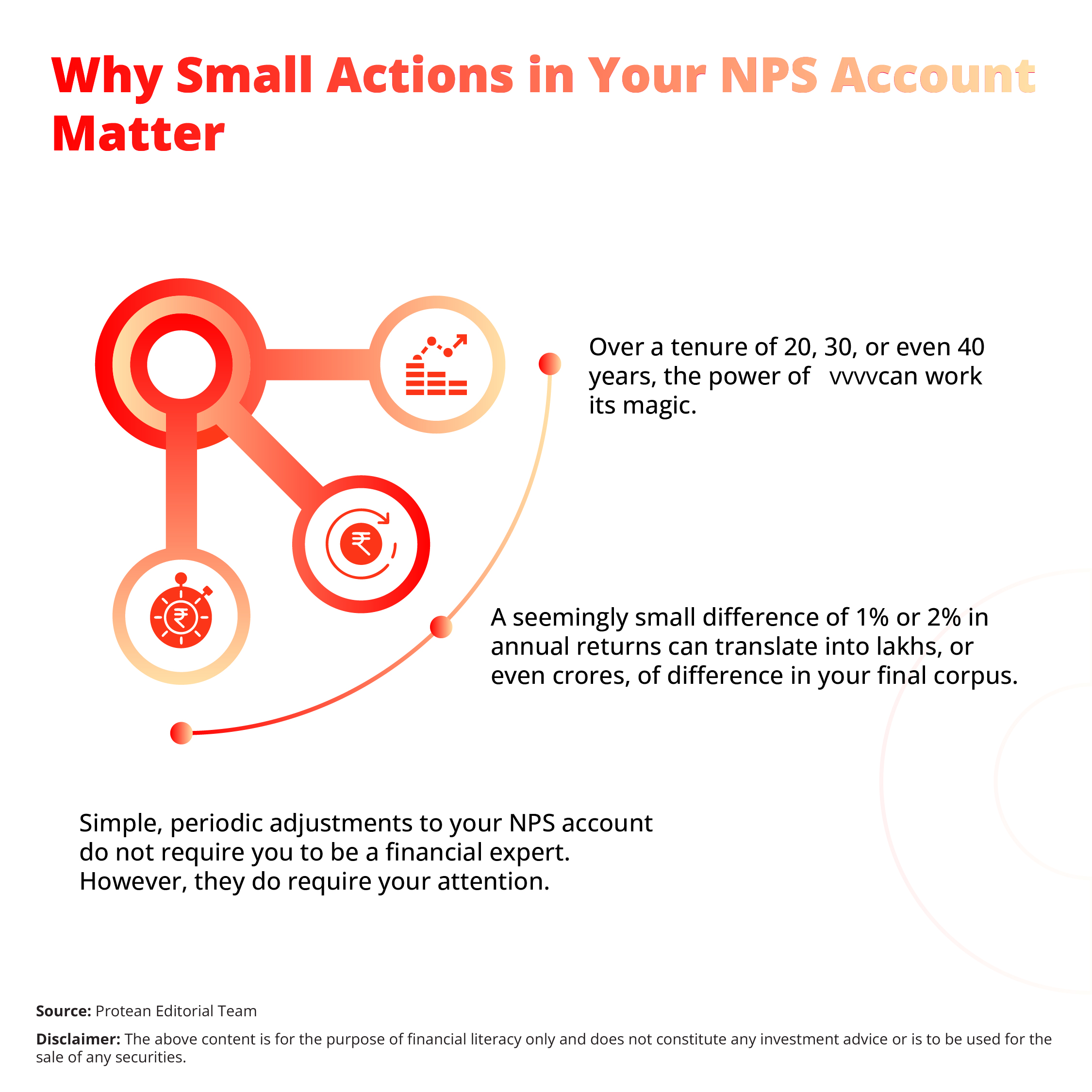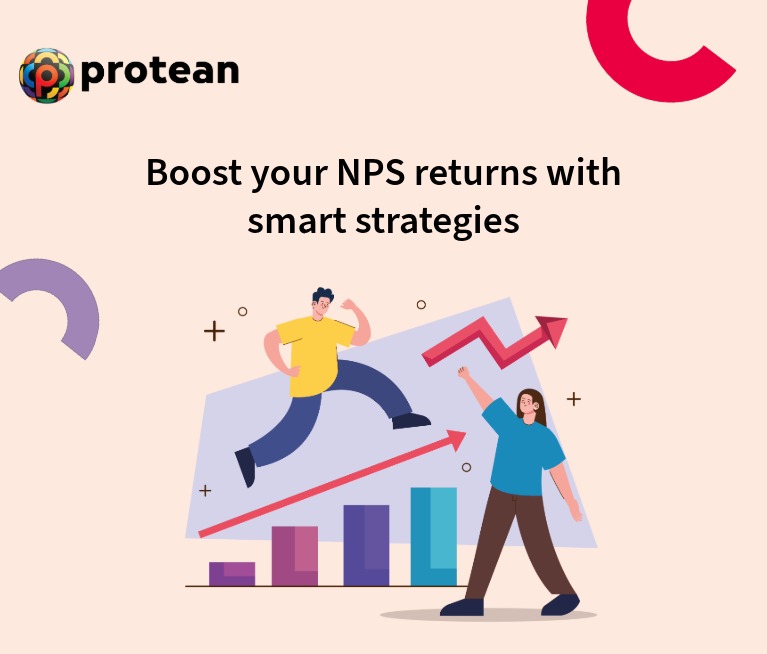Are you curious to know about NPS, NPS returns and the NPS account? We’ve an interesting article for you on this.
As an investor, you might mistake an NPS account as a passive, long-term holding. Do you simply contribute funds, claim the tax deduction, and let the system run its course until retirement? This "set-it-and-forget-it" approach. However, this approach can often leave significant potential for higher NPS returns on the table.
A smart NPS returns strategy might come handy in accumulating higher potential returns. Yes, your retirement corpus could be much larger with just a few proactive steps.
Let’s learn more about them.
Why Small Actions in Your NPS Account Matter
Firstly, you can understand that investing in the National Pension System (NPS) is a marathon, not a sprint. Here’s how:

Moving beyond passive participation can transform your NPS from a mere tax-saving instrument into a dynamic wealth-creation engine for your retirement.
Five Smart Strategies to Maximise Your NPS Returns
A smart and engaged approach can help you unlock your full investment potential.
Here are five actionable strategies you can implement to boost your NPS returns and build a strong retirement corpus.
1. Embrace the 'Active Choice' Investment Option
When you open an NPS account, you are presented with two investment choices. These are the Auto Choice and Active Choice options. Here are the NPS account features:
- The Auto Choice option is the default, lifecycle-based option. It would automatically allocate your funds across asset classes (equity, corporate bonds, government securities) based on your age. As you get older, it would then systematically reduce your exposure to riskier assets like equity.
- The Active Choice option can put you in the driver's seat. Within the PFRDA’s set limits you can decide the exact percentage of your funds to allocate to each asset class.
You can set the Auto choice or Active Choice option based on your risk profile and financial goals.
2. Leverage Higher Equity Allocation for Growth
Equity can be considered as an engine of wealth creation in any long-term portfolio. Under the 'Active Choice' option, the NPS account helps you to allocate up to 75% of your contributions to equity (Asset Class E). For anyone under the age of 50, maximising this equity exposure can be one of the most effective ways to enhance returns.
Equity markets are volatile in the short term, but their long-term trajectory has historically been upward. A 30-year investment horizon can provide ample time to ride out market volatility. In this period, you can benefit from the power of economic growth.
Therefore, a higher allocation to equity in your early career years can dramatically accelerate the growth of your NPS corpus. These NPS returns can give you a much larger base for compounding to work on in the later years.
3. Choose Your Pension Fund Manager (PFM) Wisely
Your NPS contributions are managed by professional Pension Fund Managers (PFMs). Here’s a selection strategy for them:
- It is a common misconception that all PFMs deliver similar results.
- There can be a noticeable difference in the performance of their schemes across different asset classes.
- A PFM that excels in managing the equity fund may not be the leader in the corporate bond category.
- Periodic review of the performance of all available PFMs is important.
- The NPS Trust and various financial portals publish detailed performance charts that rank PFMs based on their 1-year, 3-year, and 5-year returns. However, the past performance of a PFM may not be indicative of its future performance.
With NPS, you can change your PFM once every financial year, free of charge. This single action might have a considerable impact on your long-term NPS returns.
4. Contribute Consistently and Maximise the NPS Tax Benefit
Discipline is the cornerstone of successful investing. Instead of making a single lump-sum investment at the end of the financial year, you can try to contribute regularly, perhaps through a monthly SIP-like contribution.
This practice, known as rupee cost averaging. It can help you buy more units when the market is down and fewer when it is up. Thus, it averages out your purchase cost over time.
Furthermore, aim to contribute more than the minimum required amount. The NPS tax benefits can be a powerful incentive.
5. Rebalance Your Asset Mix Periodically
If you have opted for the 'Active Choice', the responsibility of managing your asset allocation rests with you.
High equity exposure might be beneficial when you are young. However, it can become riskier as you approach retirement. A sharp market correction just before you plan to withdraw could severely impact your corpus. Therefore, your investments need to be aligned with your risk appetite.
To mitigate this risk, you can also periodically rebalance your portfolio.
Conclusion
You can secure your financial future with a strong retirement corpus by using the NPS account. However, its true potential can only be realised through active and informed management. For this, you can do the following:
- Choose the right investment option
- Optimise your asset allocation
- Select a top-performing fund manager
- Contribute diligently
With the risk-aligned NPS investment strategy, you can leverage your NPS returns for a secure financial future.
Frequently Asked Questions (FAQs)
Q1: How often can I change my Pension Fund Manager (PFM) in my NPS account?
You are allowed to change your designated Pension Fund Manager once in a financial year. This change can be initiated online through the CRA (Central Recordkeeping Agency) portal like Protean eGov Technologies and is processed at no extra cost.
Q2: What is the maximum equity exposure allowed in an NPS account?
Under the 'Active Choice' option, a subscriber can allocate a maximum of 75% of their funds to Asset Class E (Equity). This limit remains at 75% until the subscriber reaches the age of 50, after which it tapers down annually.
Q3: Is it mandatory to contribute to the NPS account every year?
Yes, to keep your Tier-I NPS account active, you must make a minimum contribution of ₹1,000 in each financial year. Failure to do so can make the account dormant.

